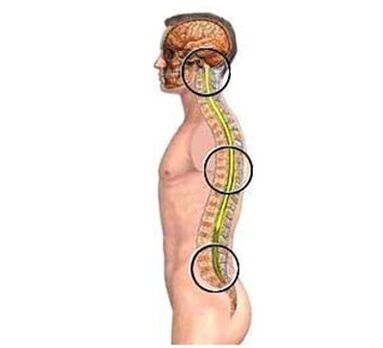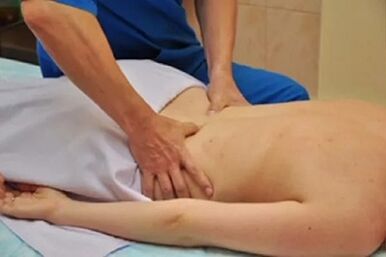Osteochondrosis is one of the most common, well-studied, but difficult-to-treat musculoskeletal disorders. This isn't just back pain and a lot of discomfort: over time, and if left untreated, osteochondrosis can lead to serious deformities and significantly affect the patient's standard of living. Hence, taking this seemingly fearless disease at the first sign is very serious.

Symptoms
Osteochondrosis very often goes undiagnosed for a long time. Osteochondrosis syndromes may not even point directly to the spine and disguise themselves as other diseases. And the patient "suppresses" the pain syndrome with painkillers and blames everything for a migraine - at best and in the worst case - he is treated for a completely different disease without seeing any improvement for years.
At the initial stage of the development of the disease, osteochondrosis manifests itself only with minor pain and discomfort after intense physical activity or long sitting in an uncomfortable position at the table. The disease develops over the years, gradually all symptoms intensify. Features characteristic of osteochondrosis of the chest region include:
- Numbness and tingling in the limbs. Especially after a long stay in one position or sleep. This is one of the first signs of a spine problem. After rubbing, numbness and discomfort pass quickly and do not cause serious discomfort.
- Cold sensations, goose bumps on the skin in the area of the hands, often - the hands or individual fingers, less often - in the affected area of the back;
- Pain sensations often have a "wrong" localization. Pain can occur in the affected area of the spine as well as radiating (giving) to the chest area when breathing, similar to pain in heart diseases. Therefore, when diagnosing osteochondrosis with pain in the heart region, an EKG will be a mandatory study - to exclude ischemic disease. Pain also often occurs in the area of the shoulder blade (intercostal neuralgia) or the left hand;
- painful sensations often intensify at night;
- The patient, too, is often tormented by headaches that resemble migraines. They can appear on one side of the head as well as cover the entire head.
- a general decrease in well-being, mood;
- Osteochondrosis of the chest region is rarely associated with compression of the spinal cord. But in this case, the symptoms are more pronounced: the sensations of pain become severe, accompanied by serious disruptions in the work of internal organs.
All symptoms of osteochondrosis are a result of the compression of the nerve roots along the spine. Symptoms can vary widely depending on the area and degree of compression. Therefore, at the first suspicion of osteochondrosis, it is very important to conduct instrumental studies and make the correct diagnosis.
Osteochondrosis of the chest region rarely occurs alone - the chest region is inactive and less stressed, most often this disease is combined with cervical osteochondrosis.
Osteochondrosis treatment methods
Like all degenerative diseases of the musculoskeletal system, osteochondrosis is treated with great difficulty and for a long time - there is no simple and quick cure. You should be prepared for this. It is impossible to reverse degenerative changes in the intervertebral discs. The ideal option is to stop the development of the disease at the initial stages, if osteochondrosis does not limit the patient's lifestyle. At the earliest stages, it is enough to only slightly adjust the patient's lifestyle: increase physical activity, complete diet. However, it is extremely rare to make a diagnosis at the beginning of the development of pathological changes.
The traditional therapeutic complex for osteochondrosis includes:
- Drug therapy. . . It consists of several components:
- With severe pain syndrome, the patient is prescribed pain medication. Most of these are nonsteroidal anti-inflammatory drugs (NSAIDs). Steroid anti-inflammatory drugs, opiates, and opioids are less commonly used. They are stronger but have many limitations in their use;
- A mandatory part of treatment is taking supplements and vitamins that strengthen the bone system.
- Muscle relaxants help relieve muscle tension. However, it should be said that taking muscle relaxants without constant exercise is strictly contraindicated in medical gymnastics.
- Taking chondoprotectors helps accelerate the recovery processes in the affected area, although the attitude of specialists to such drugs is very ambiguous.
- Drug free treatmentis much more important for the successful treatment of osteochondrosis.
- First of all, one should concentrate on the systematic and correct implementation of the complex of therapeutic gymnastics. Exercise therapy aims to strengthen the muscle corset around the spine, accelerate local blood flow and, with regular exercise, significantly improve the patient's condition.
- Physiotherapy treatments help relieve muscle pain and tension. They work like anti-inflammatory pain relievers but have far fewer contraindications.
- Massotherapy. Both traditional therapeutic massages and many alternative methods are practiced. The main selection criterion is the professionalism of a specialist and the consultation of the attending physician.
- manual therapy;
- Traction (traction therapy) on a special simulator. The gentle traction of the spine allows you to release muscle tension and reduce symptoms caused by compression of the nerve roots.
- You should also change the approach to your diet and make it more balanced.

Therapeutic exercises for osteochondrosis of the chest region
You can do medical gymnastics both in a special room in the hospital and at home. The more frequent and regular the meetings, the higher the effectiveness. It is advisable to give classes several times a day. A mandatory part of the complex is morning exercises. Each workout should last between 5 (in the first phase) and 40 minutes. The number of repetitions for each exercise should be between 5 and 20. Here is a rough set of exercises:
- Lie on your back, the surface should be flat and firm. You can comfortably put an exercise mat. Bend your knees while straightening your knee towards your nose and your head towards your knees. Hold the top point for a few seconds, then return to the starting point and switch your leg.
- A universal exercise - familiar to everyone from childhood "cat". Get on all fours with your head down. As you inhale, bend your back as far as you can and lift your head. Then, as you exhale, arch your back and lower your head.
- In the middle of the work day, you can take a break for a simple exercise: take turns lifting each shoulder as high as possible, while raising one shoulder and lowering the other.
- Sit in a chair with the back of the chair up to your shoulder blades (a regular office chair will do) and press your back firmly against the back of the chair. Then, raise your arms and bend your upper back back as far as possible.
- With your arms outstretched, make several circular motions as far as you can. Performed while sitting or standing in a straight hard chair;
- Stand up straight with your feet shoulder-width apart. Cross your arms behind your shoulder blades. Bend back as much as possible in the chest area and resist with your hands.
- In a standing position, bent as much as possible, the chin tilts toward the chest and the shoulders toward each other. Hold in the lowest position for a few seconds. Then do the back movement: straighten your shoulders as much as possible, bring your shoulder blades together, and throw your head back. The exercise is done slowly and evenly.
Osteochondrosis of the chest region can develop very slowly without causing much concern for a long time. As a result, however, the patient faces many restrictions on his normal lifestyle and the fact that the standard of living is constantly falling. Therefore, when you feel the first sensations of discomfort and slight pain, you should consult a doctor.
























